Special Exhibitions Gallery
February 10 – April 15, 2017
<<Exhibition Blog>>
Share using #ParisRefashioned on Twitter and Instagram.
Paris Refashioned, 1957-1968 highlighted one of the most groundbreaking time periods in fashion history. While
many books and exhibitions about this era position London as the center of innovative,
youth-oriented design, this limited perspective overlooks the significant role that
Paris continued to play in the fashion industry. Paris Refashioned, 1957-1968 examined the combined influence of French haute couture, ready-to-wear, and popular
culture during this era, with particular emphasis on how fashion was perceived and
promoted by the American fashion press. All objects on view were selected from The
Museum at FIT’s permanent collection of more than 50,000 objects.
In 1957, 21-year-old Yves Saint Laurent was promoted to creative director of the couture
house of Christian Dior. Saint Laurent’s first solo collection for Dior included his
A-line “trapeze” dresses, ushering in an unmistakable shift toward more relaxed and,
ultimately, more youthful designs—and with it, drastic changes to the couture fashion
industry that are rarely explored in depth. The exhibition’s introductory gallery
included a selection of more than 30 haute couture garments and accessories dating
from 1957 to 1960. The clothing was arranged in a setting designed to resemble a 1950s
couture salon. In addition to an example of Saint Laurent’s “trapeze” dress crafted
from black wool, this section featured a slinky black cocktail dress from the designer’s
fall 1959 collection. This collection—which featured dramatically shorter hemlines
than his previous work—caused a stir among fashion critics and clients.
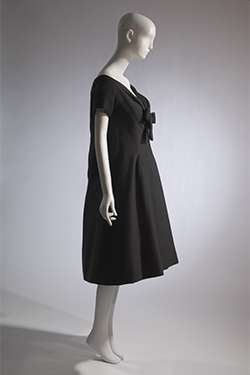
Christian Dior (Yves Saint Laurent), “Trapeze” dress, spring 1958, gift of Sally Cary
Iselin. 71.213.30
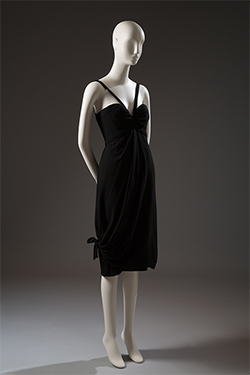
Christian Dior (Yves Saint Laurent), cocktail dress, fall 1959, gift of Robert Renfield. 2003.100.4
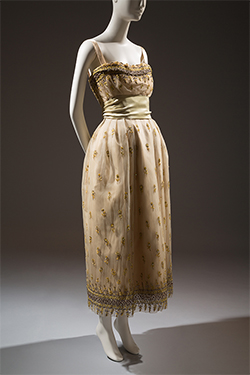
Pierre Cardin, evening dress, circa 1958, gift of Rodman A. Heeren. 72.112.38
Saint Laurent’s innovative creations was shown alongside work from other young designers
who were poised to become household names. Pierre Cardin worked briefly for Dior before
establishing his own house in 1950, and he was initially known for his designs for
suits and coats. By the late 1950s, Cardin’s collections included opulent eveningwear.
A beaded evening gown from circa 1957 exemplified his mastery of cut and detail, although
there is not yet any hint of the bold, futuristic aesthetic that would bring him fame
during the following decade.
Hubert de Givenchy, best known today for his designs for Audrey Hepburn, established
his couture house in 1951. His early associations with Cristóbal Balenciaga, one of
the most revered couturiers of the 20th century, resulted in many comparisons between
the two designers’ work. One of Balenciaga’s masterpieces—a circa 1957 lace “baby
doll” dress that foreshadowed the unrestrictive styles of the 1960s—was also be displayed.
Gabrielle “Coco” Chanel’s effortlessly stylish suits were made in seemingly endless
variations, and they became a signature of her work during the 1950s and 1960s. Several
examples were included in Paris Refashioned, including a 1959 version in red wool tweed with artfully notched “tulip”-shaped
pockets. Women of all ages embraced Chanel’s modern, easy-to-wear clothing.
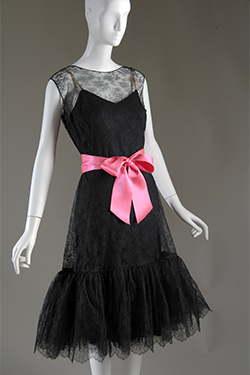
Cristóbal Balenciaga, “Baby Doll” dress, circa 1957, gift of The Costume Institute
of The Metropolitan Museum of Art from the estate of Ann E. Woodward. 87.158.2
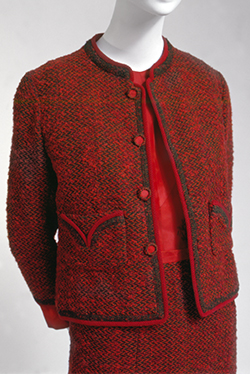
Chanel, suit, fall 1959, gift of Mrs. Walter Eytan. 80.261.2
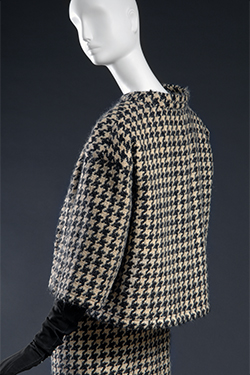
André Courrèges, suit, 1961, donated in memory of Isabel Eberstadt by her family. 2007.46.4
While the introduction of 1950s haute couture is essential to the history of French
fashion, the majority of the exhibition was devoted to the dynamic designs of the
1960s. A larger gallery space, designed to evoke a 1960s boutique, included approximately
80 examples of clothing and accessories from 1961 to 1968. This gallery highlighted
a number of fashions by André Courrèges, a protégé of Balenciaga who eschewed the
formalities of the couture industry. His preference for clean, forward-thinking design
was already evident in his first collection, presented in 1961. Paris Refashioned featured a three-piece suit from this collection, which includes a wool jacket cut
in a unique, sculptural silhouette. Later designs by Courrèges, including a pair of
his famous white leather boots and a dress trimmed in black vinyl, exemplified his
influential role as a “Space Age” designer. Pierre Cardin, too, began to design garments
that corresponded to the Space Age. On view was a minidress from his “Cosmos” collection,
worn by Lauren Bacall, that features geometric cutouts over the breastbone. Originally
styled with black accessories that included a turtleneck, patterned knit stockings,
shiny knee-high boots, and a helmet-style hat, the look helped to further Cardin’s
reputation as an avant-garde couturier.
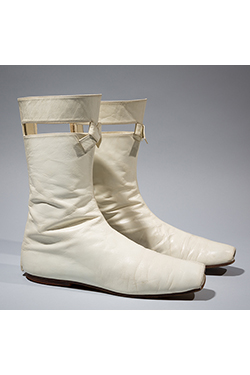
André Courrèges, boots, 1964, gift of Ruth Sublette. 77.183.2
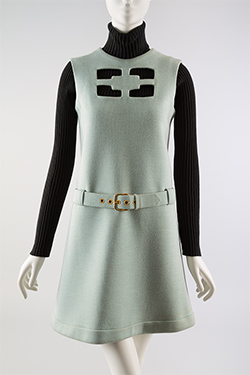
Pierre Cardin, “Cosmos” dress, 1967, gift of Lauren Bacall. 72.91.30
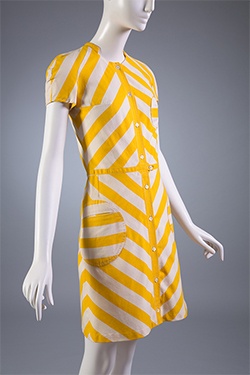
I.D. (Emmanuelle Khanh), dress, 1966, gift of Sandy Horvitz. 77.57.2
As early as 1963, a group of young French ready-to-wear designers known as the stylistes had begun to make a significant impact on fashion in their home country and abroad.
Their of-the-minute fashions, which were favored by style arbiters such as Brigitte
Bardot, presented an unexpected challenge to the more staid, costly, and labor-intensive
creations of the couturiers. The vibrant aesthetic of Emmanuelle Khanh, one of the
leaders of the French ready-to-wear fashion revolution, was represented by a striped
“Op Art” dress from 1966. The slim, youthful fit of the dress is highlighted by its
precise, mitered construction. Paco Rabanne worked with Khanh and two other prominent
stylistes, Christiane Bailly and Michèle Rosier, before gaining notoriety for his collection
of “12 Unwearable Dresses in Contemporary Materials” in 1966. Replacing fabric, needle,
and thread with plastic discs, wire, and pliers, his avant-garde creations came to
symbolize the future-forward ideals of 1960s fashion.
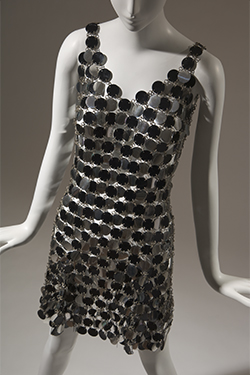
Paco Rabanne, dress, circa 1966, gift of Montgomery Ward. 81.48.1
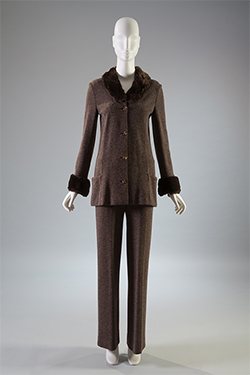
Laura (Sonia Rykiel), pantsuit, 1965, gift of Mary Cantwell. 78.159.1
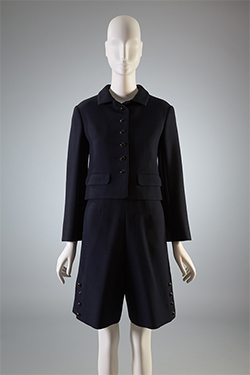
Nina Ricci (Gérard Pipart), culottes ensemble, circa 1966, gift of Geoffrey Beene. 87.41.6
Sonia Rykiel, who would later become known as the “Queen of Knits,” began her career
by designing clothing for her husband’s clothing boutique, Laura, located on Paris’s
Left Bank. Rykiel’s 1965 design for a pantsuit, made from double knit wool and trimmed
with faux fur, is at once daring, relaxed, and elegant. Gaby Aghion founded the Chloé
label in 1952, and she is considered the first to introduce the concept of luxury
ready-to-wear to French women. Aghion hired a host of esteemed designers to work for
Chloé. They included Gérard Pipart, who would later design for the couture house of
Nina Ricci, and Michèle Rosier, founder of the popular ready-to-wear label V de V.
Yet none of Aghion’s hires would become more famous than Karl Lagerfeld, who worked
at Chloé from 1964 to 1984. Paris Refashioned displayed Lagerfeld’s striking “Astoria” dress from 1967—a floor-length design, hand-painted
with a bright, floral motif inspired by Aubrey Beardsley’s artwork.
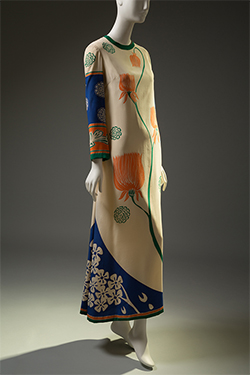
Chloé (Karl Lagerfeld), evening dress, 1967, gift of Melanie Miller. 88.84.1
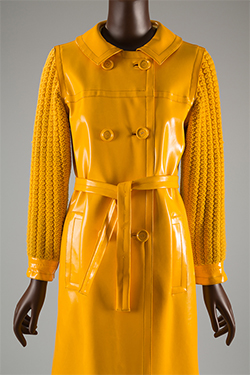
Yves Saint Laurent Rive Gauche, raincoat, 1966, gift of Ethel Scull. 77.21.4
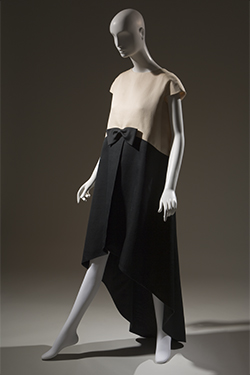
Cristóbal Balenciaga, evening dress, 1968, gift of Mrs. Ephraim London, Mrs. Rowland
Mindlin and Mrs. Walter Eytan. in memory of Mrs. M. Lincoln Schuster. 78.134.6
The success of French ready-to-wear had a profound impact on the couture industry,
and it proved to be an exciting new challenge for some designers. Cardin, Courrèges,
and Saint Laurent continued to present couture collections, but they also created
new labels for their highly stylish ready-to-wear designs. Saint Laurent’s ready-to-wear
label, Rive Gauche, allowed him to experiment with new ideas and materials—some of
which can be traced directly to the influence of the stylistes. This exhibition featured a raincoat from one of his earliest Rive Gauche collections,
made from bright yellow vinyl with chunky, knitted wool sleeves. A version of this
coat in black was worn by Catherine Deneuve in the 1967 film Belle de Jour, for which Saint Laurent designed the costumes.
Paris Refashioned concludes in 1968, the year Courrèges opened his first ready-to-wear boutique in
New York. Meanwhile, his mentor, Balenciaga, was not as keen to adapt to the changing
fashion climate. Balenciaga lamented that it had become impossible to create true
couture, and he was unnerved by the student riots in Paris in May of 1968. The great
couturier decided to close his house after more than 30 years. Nevertheless, Balenciaga’s
work from the 1960s was some of his most innovative. A 1968 gown made from black and
ivory silk gazar features the canted hemline that the couturier perfected over the
course of the decade. The overall effect is of streamlined simplicity, yet it is a
technical masterpiece.
Paris Refashioned, 1957-1968 was accompanied by a
book of the same title, published by Yale University Press in spring 2017. In addition to a comprehensive overview of 1960s French fashion by the exhibition’s
curator, Colleen Hill, the book featured essays by Dr. Valerie Steele, director and
chief curator at The Museum at FIT; Patricia Mears, deputy director at The Museum
at FIT; Emma McClendon, assistant curator at The Museum at FIT; and Dr. Alexis Romano,
independent fashion scholar and curator. The book includes stunning photographs by
William Klein, Peter Knapp, and Irving Penn, among many others.
Paris Refashioned, 1957-1968 was made possible by the Couture Council. Additional funding is provided by the New
York State Council on the Arts, with the support of Governor Andrew Cuomo and the
New York State Legislature.


















